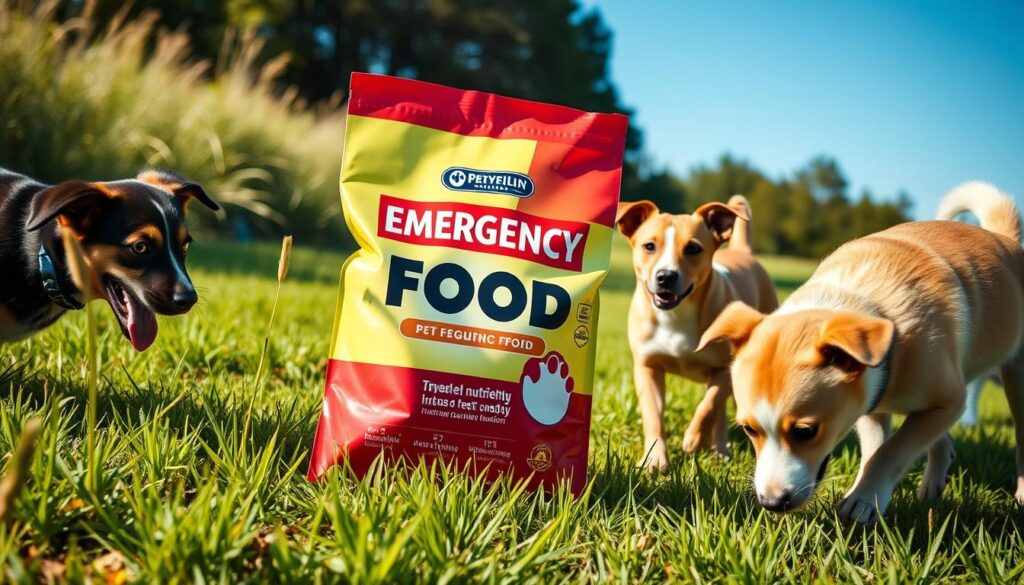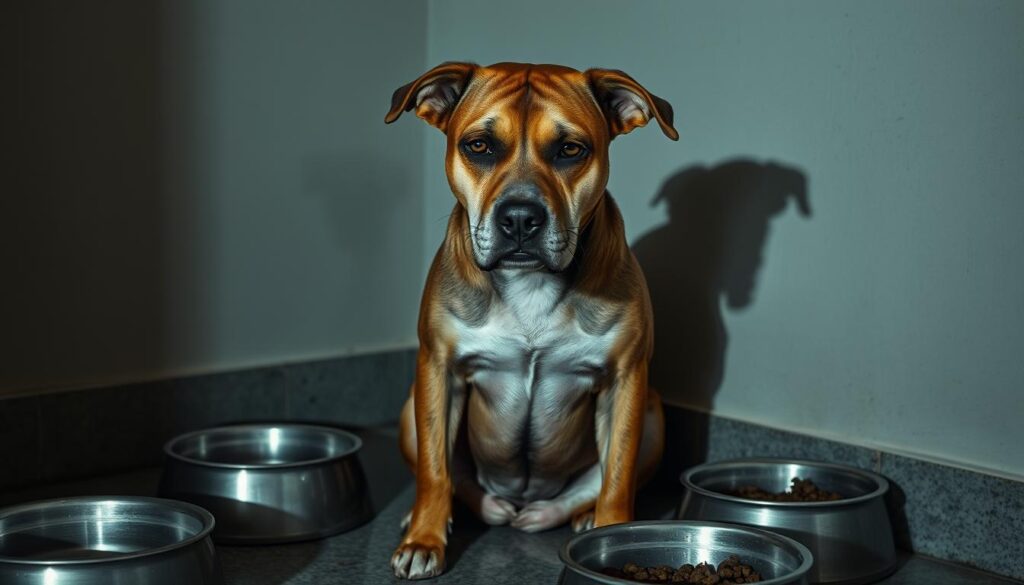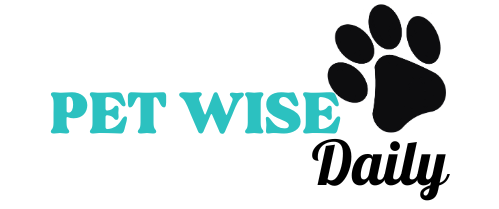Imagine your beloved dog, the furry friend who greets you with a wagging tail and eager eyes, suddenly not wanting to eat. As a devoted pet parent, the thought of your dog not eating can be unsettling. But how long can a dog go without eating before it’s a concern?
The answer might surprise you. Typically, a healthy adult dog can go 3-5 days without food without major health issues. But, it’s not safe to let your dog go that long without eating. If your dog hasn’t eaten in more than 48 hours, you need to get vet help right away.
Many things can affect how long a dog can go without food. These include their age, health, breed, and how active they are. Puppies need more food because they’re growing. Larger breeds eat more because of their size. Active dogs need more calories than less active ones.
It’s important to know what your dog needs to eat and watch their eating habits. Regular vet visits, a balanced diet, and a stress-free home are key to your dog’s health. With the right care, your dog will always have a full belly.
Table of Contents
Understanding Canine Nutritional Needs
Keeping a dog healthy means giving them a balanced diet. This diet should have high-quality proteins, fats, carbs, vitamins, and minerals. These nutrients help with growth, energy, and body functions.
Importance of a Balanced Diet
Proteins are key for muscle growth, repair, and energy. Fats are important for cell health, vitamin absorption, and skin and coat health. Carbs give energy for digestion and body processes. Vitamins and minerals boost the immune system, bone strength, and metabolism.
Common Nutritional Deficiencies
- Not enough protein can cause muscle loss and slow growth in puppies.
- Missing essential fatty acids can make coats dry and cause skin problems.
- Lack of vitamins and minerals can lead to anemia, bone issues, and weak immunity.
Signs of Malnutrition in Dogs
Malnutrition signs in dogs include weight loss, tiredness, changes in coat, and less appetite. Regular exercise helps digestion and boosts appetite, supporting nutrition.
Knowing the value of a balanced diet and spotting malnutrition signs helps pet owners. They can make sure their dogs get the right food to stay healthy and strong.
Factors Influencing How Long a Dog Can Go Without Food
How long a dog can go without eating depends on several factors. Knowing these can help owners understand their dog’s needs. It also helps spot when they need help.
Age and Health Status
A dog’s age and health are key in fasting tolerance. Puppies and older dogs need different diets than adult dogs. Puppies grow fast and need food often, while older dogs might not eat as much due to health issues.
Size and Breed Considerations
The size and breed of a dog also matter. Big dogs like Great Danes eat a lot because they’re big. Small dogs, like Yorkies and Chihuahuas, can only last 2-3 days without food. Their activity level and metabolism also play a part in their fasting ability.
Stress and Environmental Factors
Stress and changes in the environment can affect a dog’s appetite. Moving, getting a new pet, or having guests can stress them out. This stress can make them less able to fast, even for a short time.
Understanding these factors helps owners keep their dogs healthy. Regular vet visits and a balanced diet are key. They help ensure dogs stay healthy and avoid malnutrition risks. This promotes healthy fasting and overall well-being.
General Timeframes for Canine Fasting
The time a dog can go without eating varies. Healthy adult dogs can usually survive 3-5 days without food. But, it’s not safe or healthy to keep them from eating for that long.
If a dog hasn’t eaten in more than 48 hours, you must get vet help right away.
Average Duration Without Food
The time a dog can go without food depends on its size and health. Here’s a general guide:
- Small dogs (under 20 lbs): 2-3 days
- Medium dogs (21-50 lbs): 3-5 days
- Larger dogs (51-80 lbs): 5-7 days
- Giant breeds (over 80 lbs): 7-10 days
Max Duration for Healthy Dogs
Healthy adult dogs can survive up to 7-10 days without food. But, this is the maximum and not recommended. Long fasting can cause serious health problems.
When to Seek Veterinary Help
If your dog hasn’t eaten in over 48 hours, or shows signs of distress, get vet help fast. Diabetic dogs and puppies need special care. They can’t go as long without food as adult dogs.
Signs Your Dog Is Hungry
As a responsible pet owner, it’s key to know when your dog is hungry. Look for signs in their behavior and body to make sure they’re eating well. This keeps them healthy and happy.
Behavioral Indicators
- Increased begging or whining around mealtimes
- Restlessness and pacing near food storage areas
- Attempts to get into food containers or trash cans
Physical Symptoms
- Audible stomach growling or rumbling
- Lethargy and decreased energy levels
- Excessive drooling or licking of the lips
Some dogs may act hungry for attention or treats, not real hunger. Knowing the difference is crucial for your dog’s nutrition.
Differences in Appetite Among Breeds
Dog breeds vary in how much they want to eat. Labrador Retrievers, for example, are often very food-driven and show hunger more than others. Knowing your dog’s usual eating habits helps spot true hunger.
Pay attention to your dog’s signs to ensure they get the food they need. This keeps them full of energy and well. If worried about your dog’s hunger, talk to your vet.
Risks of Prolonged Food Deprivation
Food deprivation can harm your dog a lot. It can cause health problems and change their behavior. Knowing these risks is key for taking good care of your pet.
Potential Health Consequences
Not eating enough can hurt your dog’s organs and weaken their immune system. Without the right food, their body can’t work right. This makes them more likely to get sick.
Impact on Energy Levels
When dogs don’t get the nutrients they need, they get very tired. They can’t do everyday things anymore. This makes them weak and unhappy.
Long-Term Effects on Behavior
Not eating enough can also change how a dog acts. They might become more aggressive, anxious, or even depressed. These changes are hard for dogs and their owners to deal with.
In very bad cases, not eating enough can damage a dog’s stomach and other important organs. If you see signs of dog malnutrition risks or signs of dog starvation, get vet help fast.
Knowing the risks and acting quickly can keep your dog healthy and happy. Regular vet visits, a good diet, and watching for any bad signs are important. They help your dog stay well.
Hydration: The Key Companion to Food
Water is vital for your dog’s health. It makes up more than 70% of their body weight. Dogs should drink one ounce of water for every pound of body weight each day.
This means a 25-pound dog needs 25 oz. (or 3 cups) of water daily. A 75-pound dog requires nearly 2 liters of water.
Importance of Water for Dogs
Dogs need water to stay healthy and full of energy. They can go 6-10 hours without water without getting dehydrated. But, dehydration can become a big problem after 24 hours.
Signs of Dehydration
- Sunken eyes
- Dry gums
- Loss of skin elasticity
How Long Can Dogs Survive Without Water?
A healthy adult dog can survive without food for 3-5 days. But, dehydration is a serious issue after just 24 hours. The time a dog can go without water depends on their age, health, breed, and how active they are.
If your dog won’t drink water, see a vet. It could mean they have a health problem.
If your dog doesn’t want to eat, try wet food or add broth to their dry food. But, never take water away from a dog to stop them from urinating. This can cause serious problems. If your dog is vomiting or has diarrhea a lot, get emergency vet care.

How to Encourage Your Dog to Eat Again
If your dog has lost their appetite, there are several techniques you can try. The key is to make mealtime fun and cater to their preferences.
Tips for Sparking Appetite
- Warm up the food to release more aroma and flavor.
- Offer a different protein or flavor to tempt their taste buds.
- Add a small amount of an appetizing topper, like shredded intermittent dog feeding or a sprinkle of parmesan cheese.
- Provide a small portion of boiled chicken and rice (without spices) as a short-term appetite stimulant.
- Use dog emergency food as a tasty treat to coax your pup to eat, but limit these to 10% of their daily calorie intake.
Effective Feeding Techniques
Establishing a consistent feeding routine can help encourage your dog to eat. Feed them at the same times each day, in the same location, using the same bowls. This predictable structure can make mealtime more appealing.
You can also try making feeding interactive by using food-dispensing toys or rewarding your dog with small amounts of food for performing tricks. This turns mealtime into a fun activity rather than a chore.
Considerations for Picky Eaters
If your dog is a notoriously picky eater, gradual food transitions and patience may be required. Introduce new foods slowly, mixing them with their current diet to ease the transition. In some cases, veterinarians may prescribe appetite stimulants like mirtazapine or Entyce™ (capromorelin) to help get your dog’s eating back on track.
Remember, if your dog’s lack of appetite is accompanied by other worrying symptoms, such as vomiting, diarrhea, or lethargy, it’s best to consult your veterinarian right away.
Special Considerations for Puppies
Puppies need special food because they grow fast. They can’t handle fasting like adult dogs. So, they need small meals often to stay healthy. If a puppy misses meals and shows signs like vomiting or diarrhea, see a vet right away. This is because they might have serious issues like parvovirus.
Nutritional Needs of Growing Puppies
New puppies might not like new foods because of their smell, taste, and feel. Teething, which happens between 12-16 weeks and lasts 2-3 months, can make them uncomfortable. Also, unvaccinated puppies might get parvovirus, which makes them tired and not want to eat.
Puppy Fasting Guidelines
- Puppies shouldn’t fast for long because they can’t handle it like adult dogs.
- Issues like constipation, gastritis, bloat, and gastroenteritis can make puppies not want to eat. They might need vet help.
- Vaccines can make puppies not want to eat for a bit. They might also feel a little sick.
Transitioning to Solid Food
When starting puppies on solid food, do it slowly to avoid stomach problems. Puppies might get distracted and not eat. So, feed them often or right next to them. Keeping meal times the same and watching treats helps them adjust better.
| Condition | Impact on Puppy Appetite |
|---|---|
| Teething | Discomfort can lead to reduced appetite |
| Parvovirus | Lethargy and decreased appetite as initial symptoms |
| Digestive Issues | Hesitancy to eat due to discomfort |
| Vaccinations | Temporary loss of appetite with mild side effects |
When to Consult with a Veterinarian
If your dog hasn’t eaten for more than 48 hours, it’s time to see a vet. Changes in appetite can mean there’s a health issue. Dogs with diabetes, pregnant ones, puppies, or those with health problems need vet help sooner if they won’t eat.
Warning Signs to Watch For
Look out for other signs your dog might need vet care. These include:
- Weight loss
- Dehydration
- Vomiting
- Diarrhea
- Lethargy
Preparing for Your Vet Visit
When you take your dog to the vet, be ready to share important info. Talk about any changes in your pet’s behavior, appetite, or environment. This helps the vet figure out what’s wrong and how to treat it.
Common Diagnostic Tests
The vet might suggest some tests to find out why your dog isn’t eating. These could be:
- Blood work
- Urinalysis
- Imaging studies (e.g., X-rays, ultrasound)
These tests can spot health issues like infections or organ problems. Early treatment can help your dog feel better and eat normally again.

Nutritional Supplements That May Help
Nutritional supplements can be very helpful when your dog isn’t eating well. They support your dog’s health and might even make them more interested in food.
Types of Supplements to Consider
There are several supplements that could help your dog. These include:
- Probiotics to aid in digestive health
- Omega-3 fatty acids for coat and joint health
- Multivitamins to ensure overall nutritional balance
Benefits of Adding Supplements
Adding these supplements to your dog’s diet can offer many benefits. They can:
- Make your dog more interested in eating
- Boost their immune system and overall health
- Help with specific nutritional needs or health issues
Consulting Your Vet About Supplements
But, always talk to your vet before giving your dog supplements. This is especially true if your dog has ongoing health problems or is on medication. Your vet can recommend the best supplements for your dog’s specific needs.
By working with your vet and choosing the right supplements, you can support your dog’s health. This can help reduce the risks of fasting or malnutrition in dogs.
Evaluating Dog Food Options
Choosing the right food for your dog can be tough. There are many options, from dry kibble to fresh pet food. Knowing what to look for can help you pick a healthy and tasty option for your pet.
Types of Dog Food
Here are the main types of dog food:
- Dry Kibble: This is the most popular choice. It’s convenient, lasts a long time, and comes in many formulas.
- Wet Food: Canned or pouch-style wet food has more moisture. It’s great for dogs who need more water.
- Fresh Pet Food: This is called “human-grade” because it’s minimally processed. It offers a natural, whole-food approach to nutrition.
- Raw Diets: These include uncooked meat, bones, and organs. They’re based on a dog’s natural diet.
Ingredients to Look For
When checking dog food, look at the ingredients. Choose foods with real meat, poultry, or fish. Whole grains, fruits, and vegetables are good too. Stay away from artificial preservatives, colors, and flavors.
Choosing the Right Food for Your Dog
The right food depends on your dog’s age, size, and health. Puppies and senior dogs have different needs. Small and large breeds may need special formulas. Always switch foods slowly to avoid upset stomachs.
Understanding dog food types, key ingredients, and how to choose the best can help your dog stay healthy and happy.
Keeping Your Dog Healthy and Happy
Keeping your dog healthy and happy is key to being a good pet owner. Start by setting a regular feeding schedule. This should match your dog’s age, breed, and health. Puppies need more food because they grow fast.
Ask your vet for the best feeding plan for your dog.
Building a Healthy Feeding Schedule
Regular exercise and play are vital for your dog’s health. Choose activities that fit your dog’s breed and energy level. Some dogs, like Border Collies, need lots of exercise. Others, like Bulldogs, need more breaks to stay cool.
The Role of Exercise and Play
Don’t forget to take your dog to the vet regularly. These visits help keep your dog healthy and their appetite strong. Your vet can check your dog’s weight and health, spotting any issues early.
Regular Veterinary Check-Ups
By following these steps, you can keep your dog happy and healthy. A good feeding schedule, exercise, and vet visits are key. Remember, a balanced approach to your dog’s care is best for their well-being.

